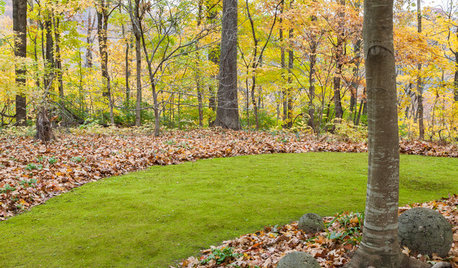Selaginella, again...
treehaus
16 years ago
Related Stories

LANDSCAPE DESIGNMoss: Nature’s Carpet for the Garden
Learn how to grow and use this ancient and mysterious natural wonder for delightful texture in the landscape
Full StoryI bought a little pot of S. uncinata a while back (some of you may recall the numerous questions I had concerning its cultivation!), and though it is still ALIVE it does not look unhappy. Or, put another way, I am not very happy with the way it looks. That is only because I remember its former glory, as it was once a deep blue, and had a very nice metallic sheen.
It has continued to grow, but it has become paler and paler - the blue is altogether gone, there is a little bit of dark green here and there, but much of it goes from shades of pale green to an almost yellow-beige! I know it was hit with a dappled dab or two of direct sun a few times when I was not looking (!), but since that time it has been in deep shade. The only ideas I have to account for its change in appearance are that the shade is too deep, or the watering regime I have it on is not right - wrong kind of water, etc. Anyone out there have ideas? How bright should the light be that it receives? This light issue continues to be a real source of difficulty for me - I am accustomed to trying to meet the needs of plants that basically require about as much direct light as you can give them (cacti, succulents, xeric plants), not to mention their tolerance of drought - the complete opposite of the ferns and selaginellas I have come to adore. Thanks in advance for any suggestions, or tips!

treehausOriginal Author
razorback33
Related Professionals
Folsom Landscape Architects & Landscape Designers · Brookline Landscape Contractors · Dallas Landscape Contractors · Darien Landscape Contractors · Fort Payne Landscape Contractors · Live Oak Landscape Contractors · Mesa Landscape Contractors · Middleton Landscape Contractors · Oxnard Landscape Contractors · Wickliffe Landscape Contractors · Huntsville Roofing & Gutters · Del Aire Decks, Patios & Outdoor Enclosures · Port Saint Lucie Decks, Patios & Outdoor Enclosures · Puyallup Decks, Patios & Outdoor Enclosures · Woodstock Decks, Patios & Outdoor Enclosuresterrestrial_man
houstonpat
treehausOriginal Author
terrestrial_man
garyfla_gw
houstonpat
treehausOriginal Author
garyfla_gw
terrestrial_man